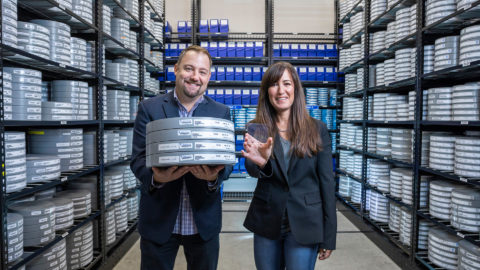Cloud network: Can Microsoft tame the mighty VMware beast?
Takeaway: Microsoft wants to own the cloud. But since clouds are built on virtual platforms, that means they need to get serious about beating VMware at its own game.
What does “all in” really mean? It means Microsoft wants to own the cloud – both the public and private varieties. To do that, they need to own the virtualization space as well, because virtualization software is one of the four basic software components on which clouds are built – along with server software, management software, and security software.
To its credit, the company seems to realize that many organizations are not ready, willing or able to trust their data and applications to the public cloud. So as much as they might be pushing their own cloud services – Azure, Office 365, Intune – their cloud strategy is all about options. If you’re into Do It Yourself cloud computing, they have a solution for you: a combination of Windows Server 2008 R2 SP 1 Hyper-V and System Center that they call Hyper-V Cloud.
As the name suggests, the Hyper-V hypervisor technology is a core component of the Microsoft private cloud. But as with many other products, Microsoft is still playing catch-up in the virtualization space, as they aim to unseat the market leader, VMware. There are other players, of course – Red Hat’s KVM and Citrix’s XenServer are the two most prominent – but when it comes to virtualization, VMware is the one to beat.
The good news for Microsoft is that Hyper-V’s market share has grown (although it’s difficult to dig out hard figures), whereas VMware’s has dropped, albeit slowly. Gartner predicted that by 2012, Hyper-V would have 27 percent of the global virtualization market with VMware at 65 percent (down from 84 percent in 2009 and 76 percent in 2010). As I’ve discussed before, coming from behind to slowly overtake the competition has long been a winning strategy for Microsoft, but some have suggested that Hyper-V’s market share has grown more slowly than expected and that might even have been a factor in the departure, early this year, of Bob Muglia as head of Server and Tools Business.
VMware got a big head start. They have been making virtualization software since 1999 and have an extensive offering of virtualization products, from VMware Workstation (which was their first product) to ESX and ESXi (enterprise-level bare-metal hypervisor implementations. vSphere is their cloud platform, which grew out of a product called VMware Infrastructure 3 that was released in 2006. What was to be VMware Infrastructure 4 was released in 2009 and was called vSphere instead.
VMware is expected to launch vSphere 5.0 next month at its July 12 event in San Francisco. One of many changes in the new version is expected to be a move away from a Windows-based console to a web-based one, which seems to signal a further subtle decoupling from the Microsoft ecosystem. This has been going on since GSX Server (a Type 2 or hosted hypervisor that ran on Windows) was phased out and replaced by ESX (a Type 1 or hostless hypervisor that runs directly on the hardware without an underlying operating system).
Microsoft is also reported to be working on a new version of Hyper-V (3.0) that includes a number of enhancements. Leaked reports have focused primarily on Hyper-V on the desktop, rumored to be a part of Windows 8. This opens up much speculation and all sorts of possibilities. I’m imagining a scenario where you could have two virtual machines running on one physical computer, with one for your work system and the other for personal tasks.
From the user’s perspective, the effect would be like Virtual Desktops on steroids. From a management and security perspective, companies could have complete control over the “work computer” and still allow users to access Facebook, personal email accounts and such on the “personal computer.” Nothing done on the personal computer would affect the work computer. If properly implemented, you could switch between the two using a simple key combination. How cool would that be?
Does this change everything?
Currently Microsoft has a bit of a split personality when it comes to virtualization. Hyper-V is in the server operating system only, while desktop virtualization is dependent on Windows Virtual PC. WVPC is a free download that supports XP Mode in Windows 7 Pro, Enterprise and Ultimate editions. WVPC is the latest version of Microsoft Virtual PC (2007 and 2004), which was based on Connectix Virtual PC (which Microsoft bought in 2003).
Virtual PC has always been a bit quirky and although it has improved over the years, the current version is no exception. I’ve worked with both WVPC and Hyper-V and the latter is far more stable in my experience. WVPC (like Microsoft Virtual Server) is a Type 2 hypervisor. Hyper-V is a “true” hypervisor that accesses the hardware, although the Hyper-V role on Windows Server 2008 R2 runs Windows as a “privileged guest.” Hyper-V Server is the “bare metal” version.
So who ever heard of a true hypervisor running on a desktop operating system? And why would anyone want to? Some have suggested that a good, stable virtualization platform built into the client OS would allow all applications to run in VMs, increasing both backward compatibility and security. It would also make it a lot easier for users to have their Windows cake and eat Linux, too. Some have gone so far as to say this will fundamentally change the way users work.
Is it enough?
While putting Hyper-V in Windows 8 could certainly help Microsoft take over the desktop virtualization market from VMware Workstation (especially considering that VMware Workstation costs $189, or $99 to upgrade from a previous version), they’ll have to do more to dominate in that private cloud space they’re eagerly courting. I suppose one could look at the Windows 8 Hyper-V as the “gateway drug” that Microsoft will give away for free, hoping that once IT folks try it and see how much better it is than Virtual PC, they’ll be impressed enough to think that maybe they should give Hyper-V Server a try, too. And that might work, to some extent – especially when it comes to new deployments.
But getting a large customer base to switch from vSphere virtualization environments will require more compelling advantages. VMware has a loyal fan base of long-time users and winning them over won’t be easy.
One way to compete is on price, and the company claims to provide more features than vSphere at one third of the cost. A real world cost comparison is difficult because of differing licensing methods. For example, total cost of Hyper-V is dependent on whether you use the Standard, Enterprise or Datacenter edition of Windows Server 2008 R2 or the standalone Hyper-V Server, and licensing for those is per-host whereas vSphere licensing is per-CPU.
Additionally, Virtual vCenter Server is priced at one amount to manage the full infrastructure, whereas System Center Server Management Suite is priced per processor. Nonetheless, if Microsoft can demonstrate significant actual cost savings – both up front and ongoing – that could be a powerful draw for companies in these still-tough economic times.
More important than absolute numbers is the issue of value – getting the most features and functionality for the money. To beat VMware, Microsoft will have to show that it’s not just the “cheap solution,” but also the best.
It is important to keep in mind that the private cloud is all about services automation – giving users the applications they need without the administrative overhead those applications traditionally require. Here Microsoft has the advantage of deep insight into the major tier one services that are deployed in a private cloud: email, messaging, collaboration, database, CRM, VDI. Microsoft fully understands these services because, after all, they make the software. Just as they need to push their ability to integrate the Windows Phone OS more tightly with Exchange, SharePoint, SQL Server etc. better than any other phone OS, they should use their extensive experience building these tier one services to persuade customers that a cloud built on Hyper-V will better integrate with said services.
Some would say hypervisors are becoming commodity items; they’re often given away for free (Microsoft Virtual PC, Microsoft Virtual Server, Hyper-V Server, VMware Server/GSX Server, VMware ESXi, XenServer). Thus the real “value add” lies in the management tools. Microsoft has built a robust management infrastructure, and it is becoming more so.
Microsoft’s strategy here is to extend the management tools into the applications that run in the VMs. System Center can provide very comprehensive application level monitoring and management, and Microsoft is positioning it as the best overall management solution because it’s compatible with VMware in side-by-side deployments. This is important because many companies are not going to suddenly dump VMware for Hyper-V, but will be willing to try Hyper-V if they can deploy it alongside their existing VMware deployments.
Much as Microsoft would like Windows Server to be the basis of all virtualized services, in order to win over VMware customers, they need to position Hyper-V as OS-neutral and emphasize that there are management packs available for other operating systems such as Red Hat and SuSE Linux.
It’s all about the options
I think of Microsoft as the company that gives me plenty of options. I know this drives some people crazy, especially in the consumer space. I constantly hear complaints that Windows 7 comes in too many editions. But I like that about Microsoft, and I think they can play up this factor in the virtualization market, as well.
For example, VMware offers a VDI solution, but Microsoft offers VDI or Remote Desktop Services (terminal services) with App-V and Windows RemoteApp. They’re also offering many deployment options for the private cloud, ranging from complete “do it yourself” (with detailed instructions) to a “fast track” option where Microsoft partners such as Dell, Fujitsu, Hitachi and HP provide an appliance-based solution.
Multiple options give customers flexibility and more control – but the problem with having many options is that it can add complexity that requires more effort to deploy and manage. To beat VMware, Microsoft will have to show that their products will simplify customers’ lives rather than introduce added work. They should emphasize how System Center can be used to manage the entire infrastructure, including VMware virtual machines, and try to win customers over on a “slow and steady” basis rather than trying to sell them on migrating to a whole new virtualization platform all at once.
Security, security, security
One of the biggest headaches in operating an on-premise IT infrastructure, as well as one of the top concerns about moving to the cloud, is security. Despite all its efforts to build security into its products from the ground up through the Trusted Computing initiative, Microsoft still suffers from the public perception that its products are not secure. Hyper-V is seen by many as “inherently insecure because it runs on Windows.”
To beat VMware, Microsoft must tackle this perception from two angles: Show that Windows Server 2008 R2, kept properly updated, is a highly secure OS and decouple Hyper-V from Windows in the minds of the public by placing more emphasis on Hyper-V Server vs. the Hyper-V role in Windows Server.
Microsoft also needs to come up with a counterpart to vSphere’s VMSafe (for integrating third party security solutions into the virtualized environment) and its Site Recovery Manager (for automating the disaster recovery process). These are two big selling points for vSphere.
Marketing makes it or breaks it
Microsoft’s market prowess (or lack thereof) is a subject for an entire column of its own, and I’ll do that one day soon. Suffice it to say that experience has shown over and over that having a great product at a great price isn’t enough to ensure success. You have to know how to get your message out to those who make the buying decisions.
Microsoft has the same marketing problem with Hyper-V that it has with Windows, Internet Explorer, Windows Phone and pretty much all of its products. They build a version that has many fundamental flaws and then improve on that as time goes by. After a few tries, they have a pretty good, solid, competitive product – but because first impressions are so strong, many people are stuck with perceptions that once were true but now aren’t (Windows crashes all the time; Windows is woefully insecure; IE offers an inferior browsing experience).
The biggest challenge Microsoft faces in gaining market share from VMware is how to present the next generation of Hyper-V (which is rumored to have some really spectacular improvements) in a way that will overcome all the outdated or misconstrued perceptions (that it doesn’t support load balancing, that it doesn’t have storage migration, that there is no clustered file system, that it’s not scalable enough for the enterprise).
Summary
If Microsoft wants to be the main player in the private cloud space, they need to set their sights on VMware. Microsoft’s initial foray into virtualization with Virtual PC and Virtual Server seemed half-hearted at best. IT pros tried those products and found them sorely lacking in comparison to VMware. Now VMware’s reputation as the best (and in the opinions of many, only) platform for building a virtual infrastructure is deeply entrenched. Hyper-V 3.0 is in the same position as Windows 8 – it needs to knock our socks off.
For more information and a personalized IT Solutions business offer, please contact us.
Source:www.techrepublic.com



